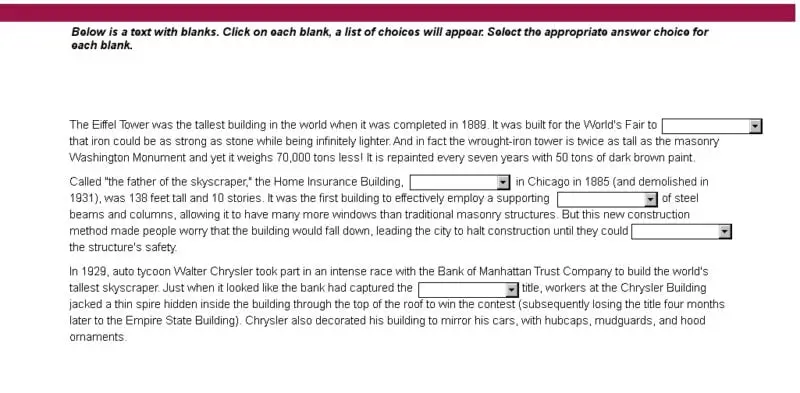
Reading and Writing: Fill in the Blanks are one of the most important question types in the PTE Academic test. You get five to six such questions in the exam, where each question will contain a passage with four to six blanks. Clicking on a blank reveals a list of options from which you should select the one that best fits the passage.
PTE Reading and Writing Fill in the Blanks question test the knowledge of vocabulary, grammar, and collocation.
How important is PTE Reading and Writing Fill in the Blanks question?
Reading and Writing: Fill in the Blanks carry a lot of weight in the PTE test. Out of the overall score of 90 in the Reading section, these question contribute 22.1. On top of that, PTE Reading and Writing Fill in the Blanks also contributes 22.3 towards the total score of 90 in the Writing section. Overall, they contain 12.33 percent of the total score.
To learn more about PTE marking criteria, click here »
Therefore, it is advisable to practice such questions as much as possible for the PTE test. And, devote the most amount of time in the exam for this question.

Tips for improving in Reading and Writing: Fill in the Blanks
Read the Entire Passage First
Before tackling the blanks, read the entire passage to understand the context and main ideas. This will help you make more informed choices for the missing words.
Identify the Theme and Tone
Determine the theme and tone of the passage. This will give you clues about the type of words that are likely to fill the blanks.
Look for Contextual Clues
Pay attention to the words and phrases around the blank spaces. These can provide context clues to help you choose the correct words.
Grammatical Structure
Analyze the grammatical structure of the sentence. Ensure that the words you choose fit grammatically and make the sentence coherent.
Use Process of Elimination
Eliminate obviously incorrect options. This can increase your chances of selecting the correct word even if you are unsure.
See also:

PTE Reading and Writing Fill in the Blanks practice
Let us segregate the question types in Reading and Writing: Fill in the Blanks so that we can learn the trick for each one.
Grammar
Most questions in the PTE Reading and Writing Fill in the Blanks module depend on your knowledge of grammar, so you have to be well-versed with common grammar rules in order to get the answer correct.
Subject-verb agreement
Consider the following example:
| Most of the appliances and machines that are used in homes, offices and factories are powered by electricity and this equipment _______________ people’s overall quality of life. |
| A helps improving |
| B helps to improve |
| C help improve |
| D help improved |
Here, see that the subject before the blank is a singular noun, so it takes a singular verb. Therefore, we can eliminate options C and D because the verb “help” is a plural verb.
Now remain options A and B. In this case, the transitive verb “helps” takes an infinite verb as its object, therefore option “B helps to improve” is the correct answer.
Another example:
| _______________ person interested in the topic, whether student or hardened expert, will find it indispensable. |
| A The other |
| B Any one of |
| C Every |
| D All |
The first word after the blank “person” is a singular word, so we have to look at singular options from the list. Options B and D take plural words, so they can be eliminated. Here, option A makes no sense in the context, therefore option “C Every” is the right answer.
| Remember: Use a singular form after the words each, either, everyone, everybody, neither, nobody, someone |
Tense and aspect
The other really important grammar knowledge for acing the Fill in the Blanks questions is knowing the structures for the three tenses (past tense, present tense, and future tense) as well as their various aspects.
Consider this example:
| China _______________ the plant for thousands of years. |
| A has cultivated |
| B cultivated |
| C cultivates |
| D had cultivated |
If you know about tenses and aspects, we use the present perfect tense for past actions that continue into the present. The structure of the present perfect tense is subject + has/have + past participle + object. The only option where this structure has been used is option A, which is the right answer.
Collocation
Collocations are often the basis of most Fill in the Blanks questions in the PTE test. Collocation means words which go together because they are part of a commonly-used phrase, create an idiomatic expression, or form a phrasal verb.
Commonly-used phrases
| For countries that do not have their own supply of natural energy resources, coal has become an essential _______________ of producing power. |
| A means |
| B factor |
| C aspect |
| D course |
This question depends on the knowledge of the common phrase “means of production”, so “A means” is the right answer.
Phrasal verbs
| Why we are living longer is not the issue for anyone _______________ in drawing up plans to market a product. |
| A linked |
| B mixed |
| C concerned |
| D involved |
Out of the given options, only the verb “involved” goes with the preposition “in”. Hence, the correct answer is D.
| According to linguists, fifty percent of these are in danger _______________ extinct. |
| A have become |
| B to become |
| C of becoming |
| D became |
Click to reveal answer »
D of becoming (in danger of is a commonly used phrasal verb)
Vocabulary
The meaning of words is absolutely important when it comes to solving most Reading and Writing Fill in the Blanks questions in the PTE Academic Reading test. Without knowing what the words mean, it would be almost impossible to get the answer right.
Here’s an example:
| It is lighter and more flexible, and these _______________ make it the ideal building material in areas that suffer earthquakes and severe weather patterns. |
| A abilities |
| B qualities |
| C talents |
| D values |
The question is clearly referring to an object, a non-living thing. Hence, the words abilities, talents and values would not fit because they are associated with people. So, “B qualities” would be the correct option here as it is the only word that we can use with an object.
| These doodles helped him develop his classic style and he grew so _______________, doing up to 40 drawings a day. |
| A perceptive |
| B proactive |
| C pedantic |
| D prolific |
Click to reveal answer »
D prolific (prolific means producing many works when referring to an artist)
Sample Questions for Practicing PTE Reading and Writing: Fill in the Blanks
Most often the questions in the exam are repeated from past questions. So, have a look at this collection of most frequently asked Reading and Writing: Fill in the Blanks questions in the PTE Reading test.
Conclusion
In conclusion, mastering the Reading and Writing Fill in the Blanks section of the PTE Academic test can significantly boost your overall score. This task not only assesses your understanding of written English but also your ability to use context to determine meaning. Regular practice, a robust vocabulary, and a keen eye for grammatical cues are your keys to success. Remember, each blank is an opportunity to demonstrate your proficiency, so approach them with confidence and precision. With the right strategies and consistent effort, you can excel in this challenging yet rewarding part of the PTE Academic test.
You may like:
• Convert PTE Score in IELTS Band